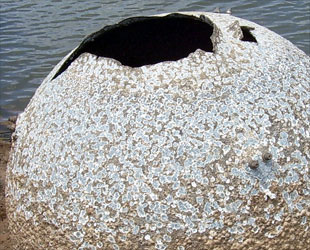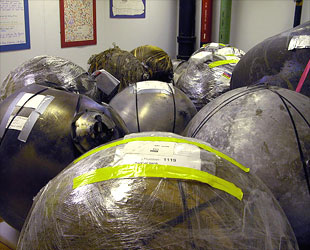August 2, 2011 — A piece of debris from NASA's space shuttle Columbia was discovered Friday in Texas, eight years after the February 2003 tragedy that destroyed the spacecraft and killed its seven-astronaut crew during their reentry into Earth's atmosphere, NASA officials confirmed today (Aug. 2).
The debris, a round aluminum power reactant storage and distribution (PRSD) tank that held cryogenic hydrogen for Columbia's electricity-generating fuel cells, was unearthed as water receded in Lake Nacogdoches, in Nacogdoches, Texas, about 160 miles northeast of Houston.
"The only reason it's exposed is because there's a drought going on and the tank was under the lake," Lisa Malone, a NASA spokeswoman at Kennedy Space Center in Florida, told SPACE.com. "The tank itself is full of mud."
The Nacogdoches police informed NASA of the find and sent pictures for identification. NASA engineers who work on the shuttle's PRSD systems were able to confirm the tank came from Columbia.

Submerged in a lake for the past eight years, the tank was found filled with mud. (Nacogdoches Police Department) |
"One of the guys had been here more than 30 years and recognized it, and said, 'That's one of the tanks,'" Malone said.
The piece was one of 18 tanks on the orbiter that stored supercold oxygen (O2) and hydrogen (H2). The spherical tank, about 40 inches (1 meter) in diameter, will eventually be shipped back to Kennedy Space Center, where NASA stores all the collected debris from Columbia in a climate controlled repository found on the 16th floor of the center's 52-story Vehicle Assembly Building.
"We're working the plans and details out right now as to how we would get it shipped back here," Malone said. "We do want to collect the debris items and keep them in one place."
To date, about 38-40 percent of Columbia and its payload has been recovered. The remainder either disintegrated as it reentered or is still where it landed across Texas and in Louisiana.
"From time to time throughout the year we do get phone calls and emails from people about items they think are debris," Malone said.

Tanks recovered after the loss of Columbia as seen a year after the tragedy at the Kennedy Space Center. (collectSPACE) |
The 2003 loss was traced back to a breach punched into one of Columbia's wing leading edges by a piece of foam that fell from the shuttle's external fuel tank during launch, according to a review board that investigated the accident. The hole permitted super-heated plasma to enter the wing, resulting in the vehicle breaking apart.
Discoveries of debris can still serve to reopen old wounds.
"It always makes you think about the accident and about Columbia and the crew of course," Malone said. "It always does serve as a reminder."
Columbia was carrying STS-107 mission commander Rick Husband, pilot William McCool, mission specialists David Brown, Kalpana "KC" Chawla, and Laurel Clark, payload commander Michael Anderson, and payload specialist Ilan Ramon, who was Israel's first astronaut.
After the tragedy, NASA upgraded equipment and revised safety procedures to protect against a similar failure. All post-Columbia shuttles flew with external tanks that had been redesigned to diminish the amount of debris from their insulating foam that fell off during ascent.
As a further precaution, recent crews conducted thorough inspections of their orbiters' heat shields once in orbit to make sure they hadn't sustained any damage that would endanger them during landing.
The loss of Columbia was the second tragedy in the three decades that the space shuttle flew. It followed the 1986 loss of the shuttle Challenger and its crew. Exceptionally cold weather at Challenger's Florida launch site that day caused a failure in an O-ring seal on one of the shuttle's solid rocket boosters that ultimately resulted in the vehicle breaking apart.
Last month NASA retired its remaining three space shuttle orbiters. The shuttle Atlantis landed July 21 to finish the 135th and final mission of the shuttle program. Now Atlantis and its sister ships Discovery and Endeavour will be retired to museums, while NASA embarks on a new program to build vehicles for deep space exploration.
